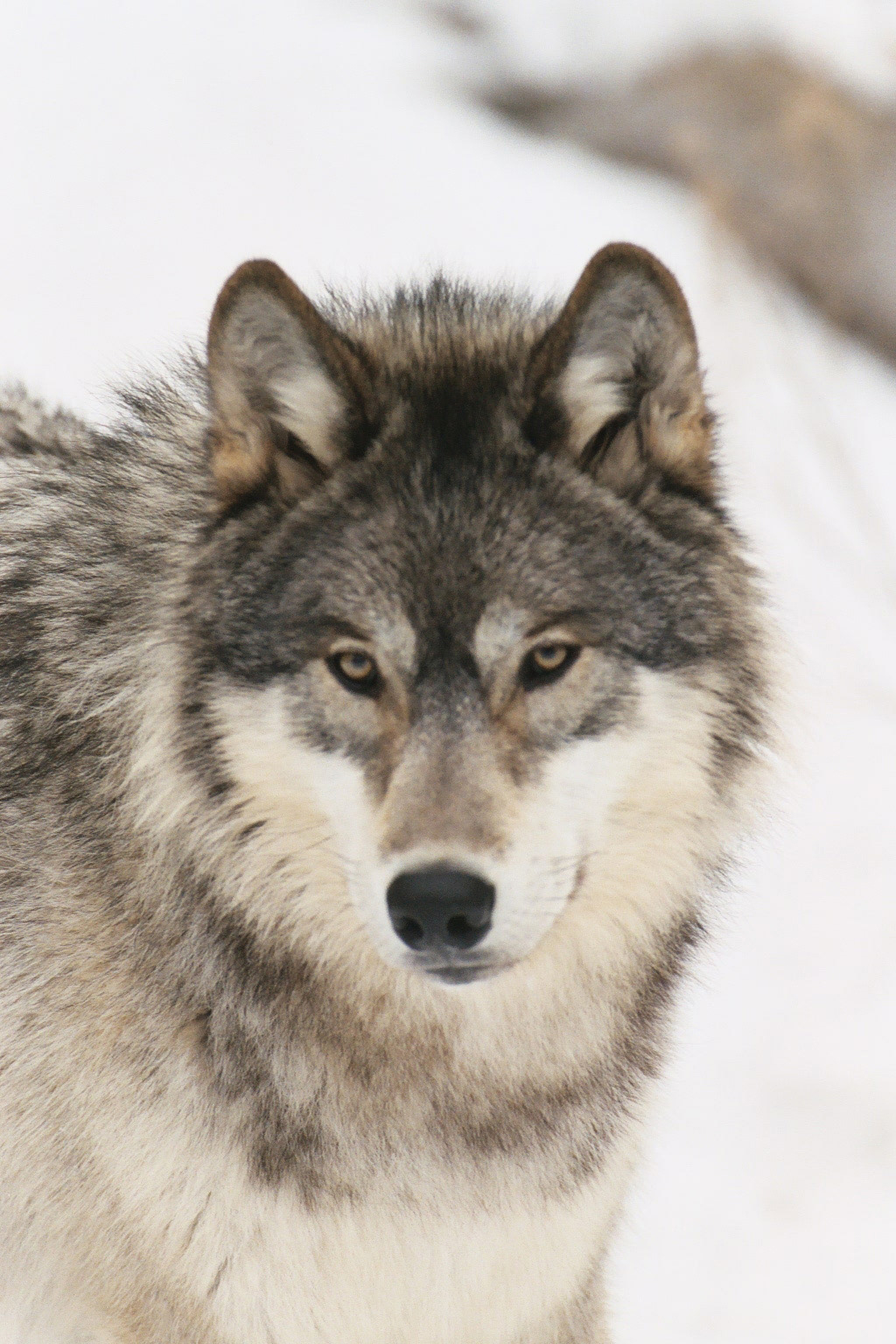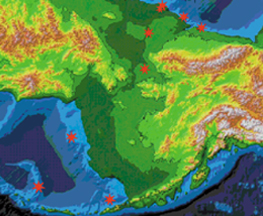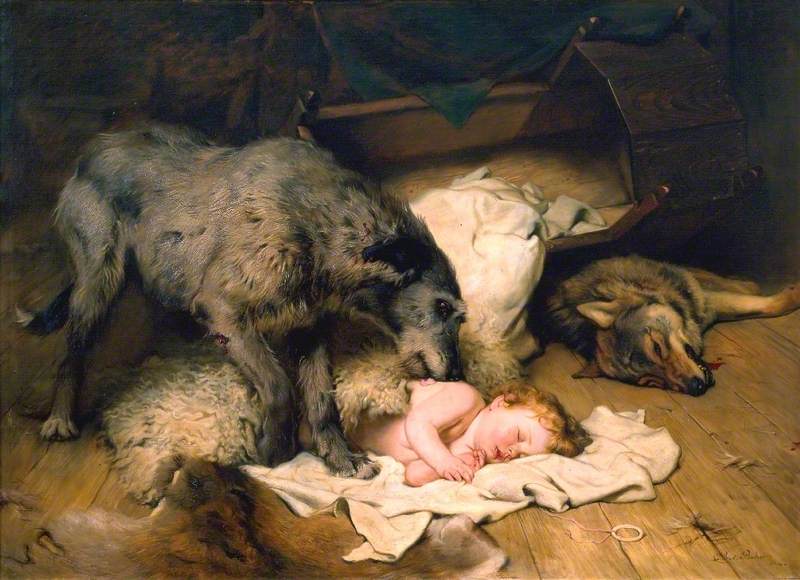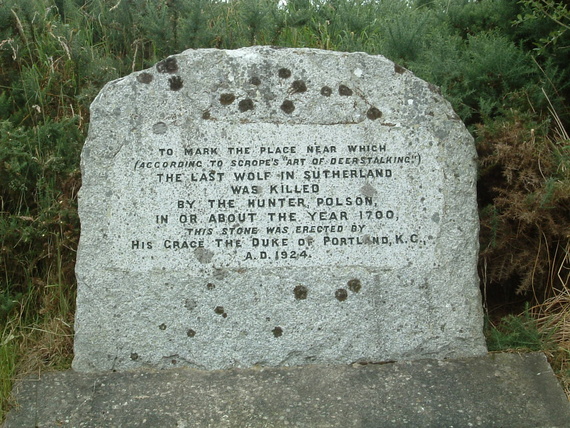Basándome en el libro "The last wolf", de Jim Crumley, me gustaría escribir unos párrafos en defensa de la que es mi especie favorita en la tierra: el lobo. En realidad, este animal ha sido perseguido y matado brutalmente en numerosos lugares del planeta en respuesta a un sentimiento de odio extendido entre la humanidad.
Sin embargo, este sentimiento no ha existido desde siempre.
A) LGM - Prehistoria.
Si nos remontamos al Pleistoceno, los lobos eran los mamíferos más comunes, y fueron los primeros en ser domesticados. Durante el Último Máximo Glaciar (LGM, hace unos 20.000 años), el nivel del mar había descendido, lo que hizo emerger una pasarela terrestre entre Asia y América del Norte en lo que hoy es el estrecho de Bering (véase Figura 1). Los grandes herbívoros de América se aprovecharon de esta conexión y la cruzaron, encontrando al otro lado ricas áreas de pasto. Los lobos persiguieron a estos herbívoros y los empujaron gradualmente hacia el oeste, y debido a ello los caballos alcanzaron las partes más occidentales de Europa.
Después de la glaciación, Canis lupus (el lobo) y Homo sapiens pudieron adaptarse a la nueva situación con relativa facilidad. A pesar de que ambos fueran cazadores, los lobos eran mejores, por lo que los humanos aprendieron de los lobos a cazar de un modo más eficaz, llegando a tratar al lobo como a un profesor. Evidencia de esto aparece en pinturas, grabados, escrituras y en el boca a boca.
B) Comienzo de las civilizaciones humanas.
La relación entre humanos y lobos se deterioró cuando los primeros se volvieron sedentarios. Con la invención del fuego, la humanidad podía crear praderas donde antes había bosques (destruyendo así el hábitat de los lobos) para que los animales domésticos pudieran pastar. Por consiguiente, proteger al ganado de los lobos se volvió necesario, lo que enfrentaría a la raza humana con los lobos.
Sin embargo, el mito de Rómulo y Remo, los fundadores de Roma que fueron alimentados por una loba y quienes trajeron la paz con las Sabinas (cuyo animal de culto era el lobo) devolvió al lobo su anterior elevado estatus.
C) Cristianismo y la Edad Media.
Cuando se estableció el cristianismo, puesto que consideraba al Señor un buen pastor, los lobos que se alimentaban del ganado eran la misma personificación del Diablo. En consecuencia, se formularon centenas de mitos que hablaban sobre feroces lobos grandes y negros que atacaban a gente corriente, lo cual alimentó el odio hacia esta especie, odio que aún sigue muy arraigado en la población humana. En este libro, el autor trata de descreditar algunos de estos mitos:
- En primer lugar, deberíamos tener en cuenta que los mitos cambian considerable y rápidamente con el paso de los años, y tienden pro lo general a exagerar progresivamente la realidad. Por ejemplo, los lobos son descritos como criaturas más grandes de lo que en realidad son (véase Figura 2) y la mayoría de las personas que nunca han visto un lobo en directo son de esta opinión. Además, ningún lobo negro ha sido encontrado en Europa, mientras que muchas historias contadas en Escocia describen lobos feroces de color negro.
- En segundo lugar, el ciervo, el reno, el alce, la cabra y el jabalí salvaje son las presas preferidas de los lobos, lo cual significa que los lobos cazan ganado solamente en caso de que los animales restantes hayan desaparecido. Por ello, si los lobos empezaron a cazar animales domésticos fue porque los humanos estaban también cazando los animales anteriormente mencionados.
- Por si esto fuera poco, dichas historias contadas en Escocia contenían aspectos increíbles y sobrenaturales (véase Figura 3): siempre había un héroe alto y fuerte, quien por cierto, guardaba cierta similitud con William Wallace; esto se explica porque los victorianos escucharon estas historias cuando estaban construyendo el monumento en honor a William Wallace en Stirling. Este personaje heroico se peleaba a fondo con un lobo muy grande y fiero que ponía su vida en peligro, pero al final, algo heroico occurría para dar una muerte increíble a la criatura.
- Estas características son mucho más comunes en los relatos conocidos como el síndrome del último lobo. Este concepto se refiere al grado de excitación en los humanos para ser aquel que ejecutara al último lobo del país (un ejemplo de esto se muestra en la Figura 4). Por lo tanto, numerosos relatos narraban el asesinato de muchos últimos lobos en diferentes partes del país, los cuales además contenían los mismos rasgos: siempre había una gran loba protegiendo a su camada, con unas características aún más fieras y escalofriantes y con la cual el héroe mantenía una batalla altamente peligrosa hasta que en un momento, él demostraba sus habilidad y su superioridad en un último movimiento que daba muerte a la gran bestia. Las semejanzas entre todas estas historias nos hace poner en tela de cuestión su grado de fiabilidad. Lo más probable es que no sean verdad y que el último lobo muriera de una simple muerte; de hecho, en una localidad se asegura que un ama de casa mató al último lobo con una sartén.
- Por último, los apellidos de guerreros y reyes de gran renombre que contienen la palabra lobo evidencian el alto estatus concedido por esta especie. Dichos apellidos son Ethelwulf (El Noble Lobo), Berthwulf (El Ilustre Lobo), Eadwulf (El Próspero Lobo) y Ealdwolf (El Viejo Lobo).
D) Actualidad.
Aún durante el siglo XX y XXI, podemos observar numerosos prejuicios hacia el lobo. A modo de ejemplo, os dejo un extracto de un libro de texto para niños publicado en Inglaterra durante el siglo XIX:
"Un aspecto salvaje, un aullido escalofriante, un hedor insorportable, hábitos fieros, y una disposición maligna son las principales características en su naturaleza, lo que lo convierte en peligroso y detestado mientras está vivo e inútil cuando muere. Por esta razón, cazar lobos es una diversión muy popular entre los nobles de muchos países; y es una especie de caza por la cual nadie debería sonrojarse o soltar ni una mísera lágrima"
Sin embargo, el lobo juega un papel primordial en los ecosistemas en los que habita. Es más, su exterminación en Escocia causó degradación paisajística, ya que la falta de este depredador repercutió en una reproducción sin control de los herbívoros, lo cual impidió que los bosques se desarrollaran libremente y en última instancia, trajo consigo degradación forestal.
Afortunadamente, en muchos sitios ya se han percatado de lo necesarios que los lobos son en los ecosistemas y han realizado grandes esfuerzos por reintroducirlos en sus hábitats. Éste es el caso de Yellowstone (véase Figura 5), donde la llegada de los lobos se llevó a cabo gracias a la tribu Nez Perce. Su aparición provocó la recuperación del sauce, que a su vez atrajo a los castores que crearon ecosistemas acuáticos donde reptiles, anfibios, alces y otros animales podían prosperar. Este fenómeno es conocido ecológicamente como cascada trófica, desencadenada por un único animal.
E) CONCLUSIÓN
Me gustaría resumir algunos de los puntos comentados anteriormente para finalizar este texto:
- Primeramente, mientras que el humano se comportaba como cualquier otro animal, todas las criaturas eran consideradas nuestros pares (incluso se solía rezar antes de cazar animales para invocar clemencia por los siguientes actos), excepto el lobo que, siendo mejor cazando, obtenía un estatus superior y era tratado como un profesor.
- Fue solamente cuando la humanidad se volvió sedentaria, y posteriormente empeoró con la llegada del cristianismo, cuando el lobo empezó siendo despreciado y eprseguido, ya que suponía una amenaza para el ganado. Aun así, ya hemos comentado anteriormente que los animales domésticos no son las presas preferidas de los lobos; éstas son otros animales (ciervos, alces...) y solamente van tras el ganado si estos animales desaparecen.
- Mitos sobre lobos que trataban de matar gente común fueron muy numerosos durante el medievo y todos ellos exageraban los rasgos del animal para hacerlo más agresivo y fiero para los humanos. En consecuencia, los seres humanos estaban aterrorizados cuando oían a los lobos aullar, pues creían que el lobo se hallaba cazando cerca, si bien podía estar hasta a 7,5 kilómetros de distancia; además, el aullido es un síntoma de comunicación, ya que los lobos cazan en silencio. Se pensaba que los lobos aullaban a la Luna, pero eso no es cierto; lo único que es verdad es que los lobos prefieren cazar cuando hay luna llena, debido a que entonces hay más luz.
- Hay todavía gran parte de la población que mantiene estas creencias medievales acerca de este animal. La gente los teme, a pesar de que los lobos raramente matan a humanos (como hemos dicho, prefieren ciertos animales salvajes, y después ganado); de hecho, más personas mueren de ataques de perros domésticos que de lobos.
- Su reintroducción, aunque lentamente, está teniendo lugar, sobre todo gracias a tribus tales como los Nez Perce (véase Figura 6). Es curioso comprobar que cuanto más cerca vive una tribu de los lobos, más les gustan, estando alejados de todos estos falsos mitos tan arraigados en las culturas urbanas. Asimismo, se ha probado que su restauración ha sido beneficiosa para el ecosistema ya que cazan herbívoros que de lo contrario, obstaculizarían el libre desarollo de los bosques.
Como conclusión, aunque creo que el autor describe a los lobos como si fueran gatitos inofensivos, básicamente estoy de acuerdo con él y comparto sus opiniones sobre la urgente necesidad de devolverlos a los hábitats que antaño ocuparon. Por supuesto, esto podrías uponer un problema para los ganaderos o pastores, pero también deberíamos pensar sobre los beneficios ecológicos que su introducción podría traer a nuestros cada vez más degradados paisajes.
BIBLIOGRAFÍA
CRUMLEY, J. (2010). The last wolf.
Fuente: http://howlingforjustice.files.wordpress.com/2011/06/winter-wolf-all-about-wolves.jpg
Sin embargo, este sentimiento no ha existido desde siempre.
A) LGM - Prehistoria.
Si nos remontamos al Pleistoceno, los lobos eran los mamíferos más comunes, y fueron los primeros en ser domesticados. Durante el Último Máximo Glaciar (LGM, hace unos 20.000 años), el nivel del mar había descendido, lo que hizo emerger una pasarela terrestre entre Asia y América del Norte en lo que hoy es el estrecho de Bering (véase Figura 1). Los grandes herbívoros de América se aprovecharon de esta conexión y la cruzaron, encontrando al otro lado ricas áreas de pasto. Los lobos persiguieron a estos herbívoros y los empujaron gradualmente hacia el oeste, y debido a ello los caballos alcanzaron las partes más occidentales de Europa.
Figura 1: El Estrecho de Bering durante el LGM. Las áreas verdes representan las tierras emergidas.
Fuente: http://www.geotimes.org/jan03/feature2_topLGM.jpg
Después de la glaciación, Canis lupus (el lobo) y Homo sapiens pudieron adaptarse a la nueva situación con relativa facilidad. A pesar de que ambos fueran cazadores, los lobos eran mejores, por lo que los humanos aprendieron de los lobos a cazar de un modo más eficaz, llegando a tratar al lobo como a un profesor. Evidencia de esto aparece en pinturas, grabados, escrituras y en el boca a boca.
B) Comienzo de las civilizaciones humanas.
La relación entre humanos y lobos se deterioró cuando los primeros se volvieron sedentarios. Con la invención del fuego, la humanidad podía crear praderas donde antes había bosques (destruyendo así el hábitat de los lobos) para que los animales domésticos pudieran pastar. Por consiguiente, proteger al ganado de los lobos se volvió necesario, lo que enfrentaría a la raza humana con los lobos.
Sin embargo, el mito de Rómulo y Remo, los fundadores de Roma que fueron alimentados por una loba y quienes trajeron la paz con las Sabinas (cuyo animal de culto era el lobo) devolvió al lobo su anterior elevado estatus.
C) Cristianismo y la Edad Media.
Cuando se estableció el cristianismo, puesto que consideraba al Señor un buen pastor, los lobos que se alimentaban del ganado eran la misma personificación del Diablo. En consecuencia, se formularon centenas de mitos que hablaban sobre feroces lobos grandes y negros que atacaban a gente corriente, lo cual alimentó el odio hacia esta especie, odio que aún sigue muy arraigado en la población humana. En este libro, el autor trata de descreditar algunos de estos mitos:
- En primer lugar, deberíamos tener en cuenta que los mitos cambian considerable y rápidamente con el paso de los años, y tienden pro lo general a exagerar progresivamente la realidad. Por ejemplo, los lobos son descritos como criaturas más grandes de lo que en realidad son (véase Figura 2) y la mayoría de las personas que nunca han visto un lobo en directo son de esta opinión. Además, ningún lobo negro ha sido encontrado en Europa, mientras que muchas historias contadas en Escocia describen lobos feroces de color negro.
Figura 2: Lobos europeos cazando un ciervo. Reparad en la diferencia de altura.
Fuente: http://www-tc.pbs.org/wnet/nature/files/2008/08/610_ag_graywolf1.jpg
- En segundo lugar, el ciervo, el reno, el alce, la cabra y el jabalí salvaje son las presas preferidas de los lobos, lo cual significa que los lobos cazan ganado solamente en caso de que los animales restantes hayan desaparecido. Por ello, si los lobos empezaron a cazar animales domésticos fue porque los humanos estaban también cazando los animales anteriormente mencionados.
- Por si esto fuera poco, dichas historias contadas en Escocia contenían aspectos increíbles y sobrenaturales (véase Figura 3): siempre había un héroe alto y fuerte, quien por cierto, guardaba cierta similitud con William Wallace; esto se explica porque los victorianos escucharon estas historias cuando estaban construyendo el monumento en honor a William Wallace en Stirling. Este personaje heroico se peleaba a fondo con un lobo muy grande y fiero que ponía su vida en peligro, pero al final, algo heroico occurría para dar una muerte increíble a la criatura.
Figura 3: relato galés de Gelert. Llywelyn the Great, mató a su perro fiel Gelert después de encontrarlo cubierto de sangre que creyó procedía de su hijo. Sólo después repara en que su hijo está todavía vivo, y lo que realmente había occurrido era que su perro había estado peleando con un lobo que Gelert había matado para poder defender al joven príncipe.
Fuente: http://upload.wikimedia.org/wikipedia/commons/e/e0/Gelert.jpg
- Estas características son mucho más comunes en los relatos conocidos como el síndrome del último lobo. Este concepto se refiere al grado de excitación en los humanos para ser aquel que ejecutara al último lobo del país (un ejemplo de esto se muestra en la Figura 4). Por lo tanto, numerosos relatos narraban el asesinato de muchos últimos lobos en diferentes partes del país, los cuales además contenían los mismos rasgos: siempre había una gran loba protegiendo a su camada, con unas características aún más fieras y escalofriantes y con la cual el héroe mantenía una batalla altamente peligrosa hasta que en un momento, él demostraba sus habilidad y su superioridad en un último movimiento que daba muerte a la gran bestia. Las semejanzas entre todas estas historias nos hace poner en tela de cuestión su grado de fiabilidad. Lo más probable es que no sean verdad y que el último lobo muriera de una simple muerte; de hecho, en una localidad se asegura que un ama de casa mató al último lobo con una sartén.
Figura 4: Memorial al último lobo in Sutherland, Escocia.
Fuente: http://www.landsendjohnogroats.info/images/northern_scotland/570/67_helmsdale6.jpg
- Por último, los apellidos de guerreros y reyes de gran renombre que contienen la palabra lobo evidencian el alto estatus concedido por esta especie. Dichos apellidos son Ethelwulf (El Noble Lobo), Berthwulf (El Ilustre Lobo), Eadwulf (El Próspero Lobo) y Ealdwolf (El Viejo Lobo).
D) Actualidad.
Aún durante el siglo XX y XXI, podemos observar numerosos prejuicios hacia el lobo. A modo de ejemplo, os dejo un extracto de un libro de texto para niños publicado en Inglaterra durante el siglo XIX:
"Un aspecto salvaje, un aullido escalofriante, un hedor insorportable, hábitos fieros, y una disposición maligna son las principales características en su naturaleza, lo que lo convierte en peligroso y detestado mientras está vivo e inútil cuando muere. Por esta razón, cazar lobos es una diversión muy popular entre los nobles de muchos países; y es una especie de caza por la cual nadie debería sonrojarse o soltar ni una mísera lágrima"
Sin embargo, el lobo juega un papel primordial en los ecosistemas en los que habita. Es más, su exterminación en Escocia causó degradación paisajística, ya que la falta de este depredador repercutió en una reproducción sin control de los herbívoros, lo cual impidió que los bosques se desarrollaran libremente y en última instancia, trajo consigo degradación forestal.
Afortunadamente, en muchos sitios ya se han percatado de lo necesarios que los lobos son en los ecosistemas y han realizado grandes esfuerzos por reintroducirlos en sus hábitats. Éste es el caso de Yellowstone (véase Figura 5), donde la llegada de los lobos se llevó a cabo gracias a la tribu Nez Perce. Su aparición provocó la recuperación del sauce, que a su vez atrajo a los castores que crearon ecosistemas acuáticos donde reptiles, anfibios, alces y otros animales podían prosperar. Este fenómeno es conocido ecológicamente como cascada trófica, desencadenada por un único animal.
Figura 5: Manada de lobos en Yellowstone, reintroducidos gracias a la tribu Nez Perce.
Fuente: http://www.wolftracker.com/TheWildSide/nez%20perce%20april%2012%20a.jpg
E) CONCLUSIÓN
Me gustaría resumir algunos de los puntos comentados anteriormente para finalizar este texto:
- Primeramente, mientras que el humano se comportaba como cualquier otro animal, todas las criaturas eran consideradas nuestros pares (incluso se solía rezar antes de cazar animales para invocar clemencia por los siguientes actos), excepto el lobo que, siendo mejor cazando, obtenía un estatus superior y era tratado como un profesor.
- Fue solamente cuando la humanidad se volvió sedentaria, y posteriormente empeoró con la llegada del cristianismo, cuando el lobo empezó siendo despreciado y eprseguido, ya que suponía una amenaza para el ganado. Aun así, ya hemos comentado anteriormente que los animales domésticos no son las presas preferidas de los lobos; éstas son otros animales (ciervos, alces...) y solamente van tras el ganado si estos animales desaparecen.
- Mitos sobre lobos que trataban de matar gente común fueron muy numerosos durante el medievo y todos ellos exageraban los rasgos del animal para hacerlo más agresivo y fiero para los humanos. En consecuencia, los seres humanos estaban aterrorizados cuando oían a los lobos aullar, pues creían que el lobo se hallaba cazando cerca, si bien podía estar hasta a 7,5 kilómetros de distancia; además, el aullido es un síntoma de comunicación, ya que los lobos cazan en silencio. Se pensaba que los lobos aullaban a la Luna, pero eso no es cierto; lo único que es verdad es que los lobos prefieren cazar cuando hay luna llena, debido a que entonces hay más luz.
- Hay todavía gran parte de la población que mantiene estas creencias medievales acerca de este animal. La gente los teme, a pesar de que los lobos raramente matan a humanos (como hemos dicho, prefieren ciertos animales salvajes, y después ganado); de hecho, más personas mueren de ataques de perros domésticos que de lobos.
- Su reintroducción, aunque lentamente, está teniendo lugar, sobre todo gracias a tribus tales como los Nez Perce (véase Figura 6). Es curioso comprobar que cuanto más cerca vive una tribu de los lobos, más les gustan, estando alejados de todos estos falsos mitos tan arraigados en las culturas urbanas. Asimismo, se ha probado que su restauración ha sido beneficiosa para el ecosistema ya que cazan herbívoros que de lo contrario, obstaculizarían el libre desarollo de los bosques.
Figura 6: mujer Nez Perce dibujada junto a un lobo.
Fuente: http://photos.igougo.com/photos/journal/pref/Nez_Perce_woman_and_pet_wolf_prefRes.jpg
Como conclusión, aunque creo que el autor describe a los lobos como si fueran gatitos inofensivos, básicamente estoy de acuerdo con él y comparto sus opiniones sobre la urgente necesidad de devolverlos a los hábitats que antaño ocuparon. Por supuesto, esto podrías uponer un problema para los ganaderos o pastores, pero también deberíamos pensar sobre los beneficios ecológicos que su introducción podría traer a nuestros cada vez más degradados paisajes.
BIBLIOGRAFÍA
CRUMLEY, J. (2010). The last wolf.










